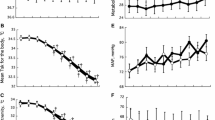Abstract
Local cooling of the nailfold capillaries produces a typical blood flow stop reaction in patients with Raynaud's phenomenon. We applied the same test to 35 patients with Crohn's disease and compared the results with the findings in a control group of 35 healthy subjects matched for age and sex by nailfold videomicroscopy. We found a flow stop with cold exposure in 27 of the 35 patients with Crohn's disease (mean duration 38 s) in contrast to 2 of the 35 control subjects only (mean duration 12 s). There was no significant difference in skin temperature between the two groups. Intravital microscopy of nailfold capillaries revealed an evident reduction of the capillary density (p=0.001) and crest diameter of the capillary loop (p=0.02) compared to normal subjects. The strong association of a vasoconstrictive reaction in finger microcirculation in patients with Crohn's disease suggests a vasospastic tendency in this disorder that might manifest in the mesenteric capillaries also. This new finding of microcirculatory disturbance may play a role in the pathophysiology of Crohn's disease and be related to a general vasospastic syndrome.
Résumé
Le refroidissement local des capillaires du pli unguéal produit une réaction d'arrêt typique du flot sanguin chez les patients atteints de maladie de Raynaud. Nous avons utilisé le même test par vidéomicroscopie du pli unguéal de 35 patients atteints de maladie de Crohn comparés avec un groupe contrôle de 35 sujets sains appariés pour l'âge et le sexe. Nous avons trouvé un arrêt circulatoire après refroidissment chez 27 des 35 patients atteints de maladie de Crohn (durée moyenne 38 secondes), par opposition à 2 seulement chez les 35 sujets contrôles (durée moyenne 12 secondes). Il n'y avait pas de différence significative dans la température cutanée entre les deux groupes. La microscopie intra-vitale des capillaires et du pli révèle une évidente réduction de la densité capillaire (p=0.001) et une diminution du diamètre de l'anse capillaire (p=0.02) comparé aux sujets normaux. L'évidente association d'une réaction vaso-constrictive de la micro-circulation digitale des patients avec maladie de Crohn suggère une tendance vasospastique qui pourrait être présente aussi dans les capillaires mésentériques. Cette nouvelle découverte de perturbation micro-circulatoire pourrait jouer un rôle dans la physio-pathologie de la maladie de Crohn et être en relation avec un syndrome vasospastique général.
Similar content being viewed by others
References
Mayer L, Janowitz H (1988) Extraintestinal manifestations of inflammatory bowel disease. In: Kirsner JB, Shorter RG (eds) Inflammatory bowel disease. Lea and Febiger, New York pp 299–317
Knox RL, Schachat AP, Mustonsen E (1984) Primary, seondary and coincidental occular complications of Crohn's disease. Ophthalmology 91:163–173
Wakefield AJ, Dhillon AP, Rowles PM, Sawyerr AM, Pittilo RM, Lewis AAM (1989) Pathogenesis of Crohn's disease: multifcal gastrointestinal infarction. Lancet I:1057–1062
Knutson H, Lunderquist A (1968) Vascular changes in Crohn's disease. Am J Roentgenol 103:380–385
Geller SA, Cohen A (1983) Arterial inflammatory infiltration in Crohn's disease. Arch Pathol Lab Med 107:473
Allen AC (1971) The vascular pathogenesis of enterocolitis of varied aetiology. In: Boley SJE (ed) Vascular disorders of the intestine. Butterworths, London, pp 92–99
Boss C, Schneuwly P, Mahler F (1987) Evaluation and clinical application of the flying spot method in nailfold capillary TV-microscopy. Int J Microcirc Clin Exp 6:15–23
Gasser P (1990) Capillary blood cell velocity in finger nailfold: Characteristics and reproducibility of the local cold response. Microsvasc Res 40:29–35
Goebell H, Hotz J (1986) Aktivitäts-und prognostische Indices bei Morbus Crohn. In: Ewe K, Fahrländer H (eds) Therapie chronisch entzündlicher Darmerkrankungen. Schattauer, Stuttgart New York, pp 3–10
Hulten L, Lindhagen J, Lundgren O, Fasth S, Aliven C (1977) Regional intestinal blood flow in ulcerative colitis and Crohn's disease. Gastroenterology 72:388–396
Lunderquist A, Lunderquist L, Knutson H (1967) Angiography in Crohn's disease of the small bowel and colon. Am J Roentgenol 101:338–344
Thiede A, Poser H, Deltz E (1982) Mikroradiographische Untersuchungen bei M. Crohn und an entzündlichen Darmerkrankungen auf frischen Operationspräparaten. In: Gall FD, Groitl H (eds) Entzündliche Erkrankungen des Dünnund Dickdarmes. Fachbuch-Verlagsgesellschaft, Erlangen pp 93–98
Carr ND, Pullan BR, Schofield PF (1986) Microvascular studies in non-specific inflammatory bowel disease. Gut 27:542–549
Brahme F, Lindstrom CA (1970) Comparative radiographic and pathological study of intestinal vaso-architecture in Crohn's disease and in ulcerative colitis. Gut 11:920–940
Johansson H, Krause U, Olding L (1972) Microangiographic studies in Crohn's disease and ulcerative colitis. Acta Chir Scand 138:409–414
Feller E, Rickard R Spiro HM (1971) Small vessel disease of the gut. In: Boley SJ (ed) Vascular disorder of the intestine. Butterworths, London, pp 495–499
Thompson H (1972) Vascular pathology of the splanchnic circulation. Clin Gastroenterol 1:597–612
Rosen IB, Cooter NB, Ruderman RL (1973) Necrotizing colitis. Surg Gynecol Obstet 137:645–649
Renton CJC (1972) Non-occlusive intestinal infarction. Clin Gastroenterol 1:655–673
Bollinger A, Fagrell B (1990) Clinical capillaroscopy. A guide to its use in clinical research and practice. Hogrefe & Huber, Toronto Lewiston, NY Bern Göttingen Stutgart, pp 121–141
Saner H, Würbel H, Gurtner H, Mahler F (1989) Increased peripheral vasoconstrictor reaction upon local cold in patients with coronary heart disease. Int J Microcirc Clin Exp 8:127–134
Gasser P, Meienberg O (1991) Finger microcirculation in migraine — A videomicroscopic study of nailfold capillaries. Eur Neurol 31:168–171
Gasser P (1989) Occular vasospasm: A risk factor in the pathogenesis of low-tension glaucoma. Int Ophthalmol 13:281–290
Author information
Authors and Affiliations
Additional information
This study was supported by the Swiss National Science Foundation, grant No. 32-9367.87
Rights and permissions
About this article
Cite this article
Gasser, P., Affolter, H. & Schuppisser, J.P. The role of nailbed vasospasm in Crohn's disease. Int J Colorect Dis 6, 147–151 (1991). https://doi.org/10.1007/BF00341235
Accepted:
Issue Date:
DOI: https://doi.org/10.1007/BF00341235




